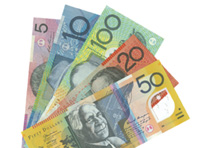Morgans demonstrate what’s really driving A$
CONFUSION over what is driving the current behaviour of the Australian dollar has prompted Morgans to issue a review of economic factors at play – and predict the ‘Aussie’ will settle at about US70cents by year end.
According to Morgans research, often investors look at the wrong signals and must grasp the reality that surges in capital investment – such as what Australia experienced in the early stages of the mining boom – can act to drive both interest and exchange rates up or down, depending on stages of a cycle. 
“Over the last year, we have seen the Australian dollar fall and interest rates fall at the same time,” Morgans research director, Roger Leaning reported.
“Many people are used to the idea that falling interest rates lead to a falling exchange rate. Fewer people are used to the idea that surges in capital investment drive both interest and exchange rates up and down at the same time.
“Commodity price stimulated investment is a good example of how investment affects interest and exchange rates particularly in Australia,” he said.
“Back in 1998, commodity prices were at the end of a cycle of long term decline and low levels of mining investment in Australia leading to low long term Australian interest rates relative to US 10 year bonds and a low Australian dollar exchange rate. 
“However, cycles come and go and the low commodity prices of the late 90s turned into a multi-year commodity price boom.”
Mr Leaning said this had an unusual, but logical effect.
“By 2010 record high commodity prices attracted record high Australian investment, which in turn led to long term Australian interest rates increasing to a level 2.5 percent higher than US 10 year bonds and a substantial rise in the value of the Australian dollar,” he said.
“Since 2010, the cycle has rolled over again. A big investment in mining has led to global increases in commodity supply and downward pressure on prices.
“The subsequent decline in mining investment means that long term Australian rates are now falling relative to the US,” Mr Leaning said. “In February 2015, Australian 10 year bond yields were just 0.5 percent higher than US 10 year bonds.
“So it is no great surprise that the Australian dollar is depreciating. Indeed by the end of this year (2015), we forecast Australian cash rates to be 2 percent or lower (the Reserve Bank reduced the rate to 2.0% in May) and expect the Australian dollar to bottom around US$0.70.
“And then, yet another investment cycle will slowly emerge …”
For an analysis on the Greece-Eurozone challenge, see the video report by Morgans chief economist, Michael Knox here.
Morgans Financial Ltd is an industry expert member of Queensland Leaders, the organisation fostering and mentoring the state’s next generation of leading companies. Morgans is Australia's largest national full-service retail stockbroking and wealth management firm, with more than 300,000 clients, 500 authorised representatives and 850 staff, operating from more than 60 offices in all states and territories.
ends

